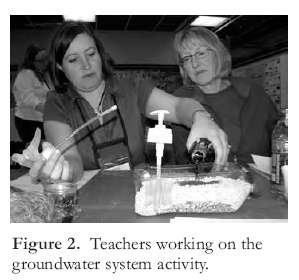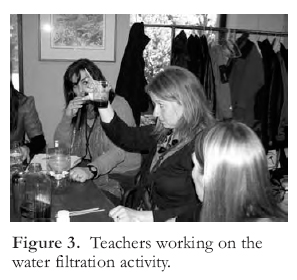Outreach
Putting the Earth into Science: Resource, Workshop and Field Trip for High School Science Teachers at GeoCanada 2010
SUMMARY
Putting the Earth into Science is a classroom resource that takes an interdisciplinary approach to expanding Earth science content in Canadian high schools. In recent history, Earth science has struggled to be identified as a core subject in school curricula. Differing approaches of whether it is placed in social studies (geography) or science has resulted in identity confusion. Alternatively, it is often seen as a specialist area of study, and hence optional. As a solution to this problem, the National EdGEO Workshop Program has developed a series of curricula-based lesson plans to integrate Earth science topics into the core subjects of physics, chemistry, biology and mathematics. The program will attract teachers of diverse science disciplines, and deliver a meaningful educational experience and important career information to high school students who are largely unaware of how Earth science impacts their daily lives. Putting the Earth into Science was launched during a workshop and field trip offered to teachers across Canada in conjunction with GeoCanada 2010.
SOMMAIRE
La Terre en science est une source référence d’activités pédagogiques interdisciplinaires visant à accroître le contenu en sciences de la Terre du programme secondaire des écoles canadiennes. Ces dernières années, les sciences de la Terre ont peiné s’imposer comme matière essentielle du programme scolaire. Selon l’approche, elles étaient tantôt incorporées aux sciences sociales (géographie), tantôt aux sciences physiques, d’où la confusion. Elles sont aussi perçues comme matière spécialisée, et optionnelles à ce titre. Comme solution, le National EdGEO Workshop Program a mis au point une série de plans de cours permettant d’intgérer des thèmes de sciences de la Terre aux matières obligatoires comme la physique, la chimie, la biologie et les mathématiques. Le programme intéressera les enseignants de diverses disciplines scientifiques, et leur proposera une démarche éducationnelle riche, et offrira aux éléves du secondaire les informations essentielles sur la profession, eux qui ignorent en grande partie l’impact des sciences de la Terre dans leur vie quotidienne. La Terre en sciences a été lancée officiellement à l’occasion de la tenue d’un atelier et d’une excursion offerts aux enseignants canadiens lors du congrès GeoCanada 2010.
INTRODUCTION
1 Teachers and outreach professionals in Earth science all state that a major issue for society is the ‘disconnection’ between the general public, especially the present student generation, and the natural world. Strong Earth science education can bridge this gap, yet Earth science courses in elementary and secondary school programs across Canada are few and far between, especially at high schools. Where specialist Earth science credits are offered in high school, they are optional courses and taken by a relatively small number compared to other sciences. We accept that without a radical change in our education systems, specialized study of Earth science will most likely always be a minority subject. For many years, EdGEO has successfully supported teachers of these Earth science courses, but it was perceived that an alternate approach was needed to achieve EdGEO’s goals of increasing the understanding of all students about the Earth and how it works. To do this required a broader audience, so our target became courses which are either compulsory for all students or offered more widely than specialized Earth science designated credits. The springboard for this strategy came from projects already having impact in the United Kingdom: the Joint Earth Science Education Initiative and the Earth Science Education Unit [http://www.rsc.org/Education/Teachers/Resources/jesei/ and http://www.earthscienceeducation.com].
2 The development of the resource and the implementation of the workshop was part of an overall plan developed at a workshop of Earth Science Outreach experts that took place at the Geological Association of Canada meeting in Yellowknife in 2007 (Nowlan and Schreiner 2007). At that meeting of more than thirty Earth science education and outreach experts, it was agreed that we should try to ‘wedge’ Earth science into Canadian science and social studies curricula. Over time, the term ‘wedging’ was considered unnecessarily aggressive, but the need for making Earth science examples available to high school teachers remained a priority. Therefore, the idea behind Putting the Earth into Science was to provide a resource document containing Earth science-related activities for biology, chemistry, physics and mathematics curricula in grades 9–12 across Canada. The teaching material would be introduced to the target audience through professional development workshops. To this end, EdGEO applied for, and received, a grant from the Canadian Geological Foundation ($13 500) to support the development of materials by one of us (Stella Heenan, an Ontario-based geo-physicist and educator). This was supplemented by generous support from Natural Resources Canada for the execution of the workshop and field trip. The printed documents that constitute the resource can be viewed and downloaded at http://www.edgeo.org/images/pdf/putting-the-earth-into-science/putting-the-earth-into-science.pdf.
STRATEGY FOR RESOURCE DEVELOPMENT
3 The first step in choosing student activities to be included in the resource was to establish a series of fundamental Earth science literacy statements: what are the far-reaching concepts that all individuals in society would benefit from understanding? Based on material from the Earth Science Literacy Initiative (see www.earthscienceliteracy.org), these statements are:
- The Earth is a complex system of integrated and interacting subsystems.
- Earth scientists use many tools to observe and study the Earth.
- Earth is a dynamic entity that changes over time.
- Evidence of the Earth’s past environment and climate is recorded in many places.
- Information and observations of the present-day Earth are used to understand past events.
- Many natural processes are cyclic and repeat over time.
- Natural processes are continuously changing the landscape around us.
- Natural processes affect the environment and people.
- Understanding Earth systems can help mitigate the negative effects of human activities.
- We use natural resources to create almost everything around us. Anything not developed from a plant or animal resource was mined.
- Water supply and consumption is a major issue affecting global society.
- Studying natural hazards can provide valuable information to mitigate their effects.
4 The next step was to review the high school chemistry, physics, biology and mathematics curricula from all provinces and territories and identify common expectations that illustrated these statements of Earth science literacy. Finally, the challenge was to create a selection of learning activities for teachers of these subjects that emphasized Earth science applications of curriculum content that they were already required to teach. In many cases it was possible to start with familiar and common activities, and by adding an application or method of approaching the task, to enhance the connection to the Earth. For example, in grades 9 or 10 biology, students study physical characteristics of organisms and adaptations to a local environment. Putting the Earth into Science includes a field study from which students establish simple correlations between characteristics and environment. They then apply that knowledge to a paleogeography exercise using fossils to interpret ancient environments. In completing both tasks, students experience the Earth science literacy statements that the Earth is continually changing, and that we study the present as the key to the past.
THE WORKSHOP
5 The workshop for teachers was held on Saturday, May 8, 2010 at the Geological Survey of Canada building in Calgary. The registration fee was $50 and participants were also able to take advantage of attendance at the Geo-Canada 2010 conference. Our goal was to involve teachers who were well positioned to expand the inclusion of Earth science into mainstream high school science and mathematics courses in their home region. This included science teachers, school board consultants, and experienced professional development presenters. To achieve this, an application form was put together and sent to selected Earth science outreach people across Canada with the hope that they would identify key teachers in their region to attend the workshop.
6 At the same time, regional and provincial Earth science organizations were approached across the country to solicit their financial support for the travel and accommodation expenses of teachers attending the workshop. Of the 25 registrants for the workshop, 21 were supported by a variety of organizations, and were also assisted in most cases by their school boards. The regis-trants came from eight provinces: British Columbia (3), Alberta (3), Saskatchewan (10), Manitoba (1), Ontario (4), New Brunswick (1), Nova Scotia (2) and Newfoundland and Labrador (1). A list of the Earth science organizations that supported teachers is included in the appendix. The estimated total level of support approached $23 000 and the workshop could not have taken place without these multiple contributions.
Goals for Workshop Participants
- To be guided in the implementation of Putting the Earth into Science as a resource for high school chemistry, biology, physics and mathematics teachers, rather than teachers of Earth science;
- To internalize and expand upon the concept of teaching about the Earth in all science and mathematics courses;
- To experience as many of the activities as possible in a hands-on fashion, to ensure that the activities could be confidently replicated and facilitated in a classroom;
- To share ideas aimed at encouraging non-Earth science teachers to deliver the contents of the resource; and
- To establish expectations and strategies for delivering professional development to their local colleagues.
Workshop Delivery Strategies
7 The challenge in facilitating the workshop was to ensure that the goals were clear throughout the day, because the materials are designed for chemistry, biology, physics and mathematics teachers, not Earth science teachers, and for all students, not only those who may go on to become Earth scientists.
8 As participants arrived, they were presented with a ‘loot bag’ of items (e.g. dice, marble, feather, floating bright-coloured ball and magnet) and asked to imagine how they would use one item from the bag to teach something about the Earth. As an ice-breaker activity, they shared their names, teaching assignments and loot bag ideas. Contributions were recorded onto prominently displayed chart paper, one for each of chemistry, physics, biology, and mathematics.
9 Introductory comments focused on the concept of Earth science literacy and also highlighted the unique aspects of Earth science from an educational perspective. It was noted that Earth science is an integrated multidisciplinary science requiring the development and application of diverse and complex skills that include identifying components of systems, recognizing cyclical processes, and developing cause-and-effect reasoning. In addition, it was explained that Earth science also demands abstract thinking skills for recognizing patterns, visualizing the unseen, dealing with ambiguous data, understanding temporal and spatial scales, developing the spatial-perceptive ability to switch between planar and three-dimensional views, and for synthesizing information in models.
10 The main part of the workshop allowed small groups of participants to perform three rounds of six activities each from the handbook provided (Fig. 1). Equipment for all 18 tasks was available, and in most cases teachers were able to experience and complete the task in the same way that students would (Figs. 2 and 3). During lunch and break times, an additional 12 activities were laid out in print form for browsing and comment. Alternating with the activity sessions were an invited speaker who addressed the importance of understanding the Earth, and a presentation on the new Earth science careers website.
11 The workshop participants were an exceptional and knowledgeable group that included many with first and higher degrees in Earth science, experienced educators, and three board-level consultants. Every person was passionate about increasing students’ understanding of the Earth. The delivery model pointedly addressed these characteristics: the facilitators’ questions were designed to repeatedly draw on the expertise of the group; in reflecting on each round of activities with their colleagues, they shared the curriculum applications, extensions, modifications, pedagogy, and challenges and solutions for implementing the stated goals. This was not a oneway delivery from a presenter – the dynamic interactions and discussions between participants were outstanding and increased the educational value of the workshop.
12 Participants received a digital copy of the resource on CD-ROM, high quality prints of some of the activity cards and images, materials to complete some of the activities, and a wide selection of posters and information sheets to supplement their lessons.
13 The principal workshop instructor was Stella Heenan and the volunteer helpers included Laura Clinton (PDAC Mining Matters and Chair of EdGEO), Beth Halfkenny (Carleton University), Fran Haidl (Saskatchewan Geological Survey), Amanda McCallum (Geological Survey of Newfoundland and Labrador) and Godfrey Nowlan (Geological Survey of Canada).
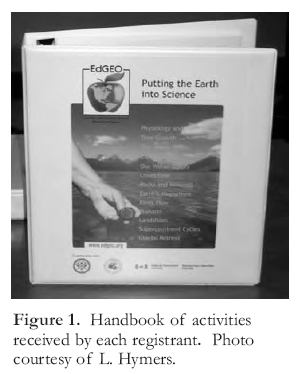 Display large image of Figure 1
Display large image of Figure 1Impact of the Workshop
14 Reviews of the workshop were extremely positive, with all participants rating the workshop as outstanding or excellent. Participants enjoyed the hands-on, practical and diverse activities that can be used in the classroom and shared with colleagues. The alignment of content with new, inquiry-based learning techniques was appreciated. The approach to activities was described as exceptional: "keeping us engaged and interested all day." Many cited their desire to have additional time to explore the activities in greater detail.
15 Teachers attending the workshop were encouraged to provide similar workshops for teachers in their respective regions so that knowledge of these activities could spread. For this purpose, some of the funds raised for the workshop were later available as EdGEO grants to teachers giving workshops in their local area; since the Calgary workshop, many participants have in fact shared Putting the Earth into Science with their local colleagues and have become more involved with Earth science outreach. A few examples of outreach stemming from the workshop are outlined below.
Newfoundland and Labrador
16 Our participant from Newfoundland and Labrador (NL) is currently on a committee to develop a new Earth science course for NL high schools and is advocating for the new course to be offered throughout NL, including distance education. He is committed to being involved in a major in-service for NL science teachers, in partnership with the Geological Survey of Newfoundland and Labrador and Memorial University, which will accompany the roll-out of the new Earth science course. It is hoped that such exposure will bring non-geology teachers on board to offer the new curriculum. Since participating in the Calgary workshop, he has injected as much Earth science as possible into his Grade 10 general science classes and provided examples to the other teacher of the course so that his class experiences the same exposure.
Nova Scotia
17 The two participants from Nova Scotia collaborated to facilitate a workshop for 24 teachers at the Bedford Institute of Oceanography as part of the EdGEO summer workshop and field trip program. Copies of the resource on CD were distributed. In addition, a workshop to share the resources was delivered to 12 teachers during the annual conference of the provincial Association of Science Teachers. One teacher participant reported using several of the lessons in Grade 10 general science classes.
New Brunswick
18 A workshop will be presented during the provincial professional development days in May, in Miramichi, hosted by the New Brunswick Teacher Association. In addition, a course entitled "Introduction to Earth Science 120" is approved for the winter 2011 semester at Bernice MacNaughton High School in Moncton. The resources and assessments for the course will be made available through www.bms.ca/moodle. Discussions have been initiated to explore the possibility of Grade 12 geology classes receiving credit at the University of New Brunswick.
Ontario
19 In November, a 1-hour session highlighting the resources’ purpose and activities was delivered at the Science Teachers’ Association of Ontario conference in Toronto. In excess of 45 teachers attended, all of whom taught at least one of the core sciences of biology, chemistry and physics, plus the grades 11 and 12 Environmental Science courses. Participants experienced nine of the tasks, and the facilitators demonstrated for each one how subject content could be used to enhance students’ understanding of the Earth. As an added incentive, the first 30 participants at the workshop received a bag of materials to help them deliver the activities. The resource has also been promoted through the Prospectors and Developers Association of Canada (PDAC) Mining Matters educator newsletter, and Mining Matters hosted a Putting the Earth into Science workshop for teachers in at the Toronto PDAC Convention in March 2011.
20 The resource was also highlighted during a two-hour workshop for 30 geography teachers at the annual OAGEE (Ontario Association of Geography and Environmental Educators) Conference in October of 2010, held in Ottawa. The workshop was intended to bring resources and support to those teaching the Physical Geography portion of the Ontario High School curriculum. Participants had the opportunity to try out some of the activities contained in the EdGEO resource and were enthusiastic about the value to their students of the hands-on investigations. A Teachers’ Workshop to be held in conjunction with the GAC–MAC 2011 Conference in Ottawa will feature the resource and its activities as part of the program for the day.
Manitoba
21 The resources have been set up as a kit for teachers to book and use in their classes along with lesson ideas. A second kit, specific to rocks and minerals, was put together for teachers to book from a central resource library. The package "Putting the Earth into Science" was copied and distributed to all high school science department heads within the Winnipeg School Division as well as the participants at the Manitoba Teacher’s Society Annual Conference. Two Earth science workshops were facilitated during this conference. Websites and other information were shared electronically with all science department heads and science contacts in the Winnipeg School Division schools. All updates from the Canadian Geoscience Education Network are now also shared in a timely manner.
Saskatchewan
22 One of the Saskatchewan participants facilitated a professional development workshop during a local conference for teachers. She has shared the resources through a collaborative technology science group.
Alberta
23 One of the representatives from Alberta facilitated a professional development workshop during the provincial conference for science teachers.
THE FIELD TRIP
24 The field trip, entitled Education and Learning at the Royal Tyrrell Museum, took place on Saturday, May 9, 2010, with 36 registrants. GeoCanada 2010 conference delegates were offered spaces on the trip and most workshop participants and presenters went as well (Fig. 4). Registration for workshop participants was $50 and for full conference delegates it was $100. The trip by coach from Calgary to the Royal Tyrrell Museum in Drumheller was accompanied by a commentary on geology and culture and a stop at Horseshoe Canyon. The weather did not cooperate because it rained through Friday night in Drumheller, making access to the badlands impossible. The badlands hike had to be cancelled and was replaced with a second activity (Fig. 5). The trip included workshops on a Cretaceous Crime Scene and Badlands/Goodlands as well as a tour of the Learning Centre (including distance learning studio). The balance of the time was spent discovering the galleries in the museum.
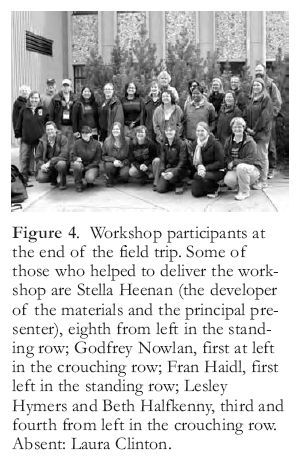 Display large image of Figure 4
Display large image of Figure 4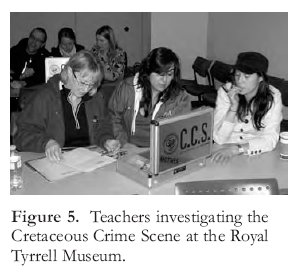 Display large image of Figure 5
Display large image of Figure 525 The trip was led by Godfrey Nowlan and Earl Wiebe (Education Director, Royal Tyrrell Museum). Despite the disappointment of not making it into the badlands on foot, the trip was instructional and enjoyed by the participants. Most of the expenses were covered by a grant from Natural Resources Canada.
THE NET EFFECT AND NEXT STEPS
26 The development of the Putting the Earth into Science resource is a landmark step in the evolution of Earth science education in high school in Canada. The workshop on this resource proved that there is an appetite for ‘real world’ examples of physical, chemical and biological principles and that there is an abundance of such examples within Earth science. The resource, which is now freely available on line at the EdGEO web site (www.edgeo.org), will have considerable value in getting more Earth science into regular science teaching practice in Canada. The fact that many participants in the workshop have already provided the materials to their local peers through workshops, courses, sessions and other events means that the workshop is having a cascading effect, reaching out to many more teachers nationally.
27 Despite the great success of this event, we should recognize that this is just a first step down an important road and we must consider additional efforts to add to this resource for serving the needs of science teachers. We should also consider developing a similar set of Earth science examples for use in the high school social studies curricula across Canada.
28 We take this opportunity to express our thanks to all the supporters of this expensive but worthwhile venture.
APPENDIX List of financial supporters for the resource, workshop and field trip
Association of Professional Engineers and Geoscientists of Saskatchewan
Association of Professional Geoscientists of Ontario
Atlantic Geoscience Society
Canadian Geological Foundation
Canadian Geoscience Education Network
College of Engineering, University of Saskatchewan
EdGEO Program of Workshops for Teachers
Geological Association of Canada - Cordilleran Division
Natural Resources Canada - Geological Survey of Canada
Professional Engineers and Geoscientists of Newfoundland and Labrador
Prospectors and Developers Association of Canada Mining Matters
Saskatchewan Geological Society
Saskatchewan Mining Association
School Boards across Canada
